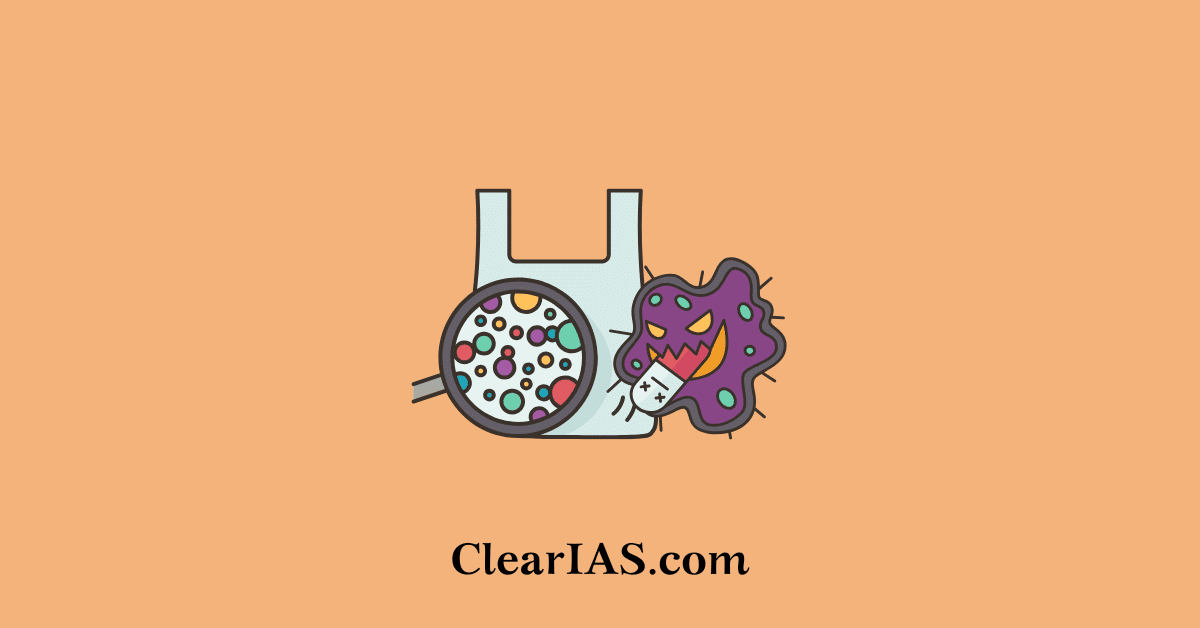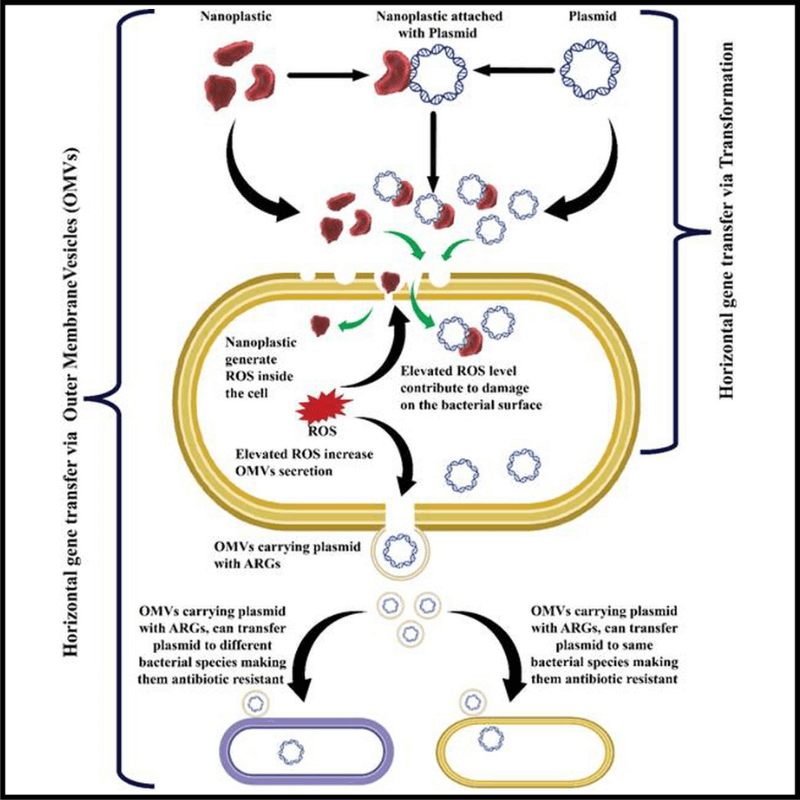
Nanoplastics from Single-Use Plastic Bottles and Antibiotic Resistance have become a Growing Public Health Concern. Read here to learn more.
A groundbreaking study by the Institute of Nano Science and Technology (INST), Mohali, has revealed that nanoplastics derived from single-use plastic bottles (SUPBs) may contribute to the spread of antibiotic resistance (AR).
This finding highlights an unrecognized public health risk that intersects the twin crises of plastic pollution and AR.
Nanoplastics and Antimicrobial Resistance

- Nanoplastics and Gut Microbiota
- Nanoplastics coexist with microorganisms in diverse environments, including the human gut.
- The study’s target was Lactobacillus acidophilus, a beneficial bacterium in the human gut, to investigate the effects of nanoplastics on bacteria.
- Mechanisms of AR Gene Transfer
The researchers identified two novel mechanisms through which polyethylene terephthalate bottle-derived nano plastics (PBNPs) facilitate AR gene transfer:- Direct Transformation Pathway:
- PBNPs act as physical carriers, transporting AR plasmids across bacterial membranes.
- This promotes direct gene transfer between bacterial species.
- OMV-Induced Transfer Pathway:
- Nanoplastics induce oxidative stress and surface damage in bacteria.
- This triggers the secretion of outer membrane vesicles (OMVs) loaded with AR genes, which become vectors for gene transfer.
- Impact on Microbial Communities
- Cross-Species Transfer: PBNPs enable horizontal gene transfer (HGT) of AR genes from E.coli to Lactobacillus acidophilus.
- Reservoir for AR Genes: Beneficial gut bacteria may become reservoirs for AR genes, increasing the risk of transfer to pathogenic bacteria during infections.
- Direct Transformation Pathway:
What are nanoplastics?
Nanoplastics are tiny plastic particles with a size of less than 1 micrometre (µm) or 1000 nanometres (nm).
They are a subset of microplastics created through the degradation of larger plastic materials or as byproducts of industrial processes.
Sources:
- Primary Sources:
- Directly manufactured for use in products like cosmetics, paints, and medical applications.
- Used in nanotechnology for their unique properties, such as strength and lightweight.
- Secondary Sources:
- Plastic Degradation: Breakdown of larger plastics through UV radiation, physical abrasion, or chemical processes.
- Industrial Waste: Released during manufacturing or disposal of plastic products.
Characteristics:
- Small Size: Easily penetrate biological membranes and the environment.
- Surface Area: High surface-to-volume ratio, increasing reactivity.
- Composition: Made of polymers like polyethylene, polypropylene, and polystyrene.
- Persistence: Non-biodegradable, leading to long-term environmental accumulation.
Environmental Impact of Nanoplastics
- Marine Ecosystems:
- Ingestion by Marine Life: Nano-plastics are consumed by plankton, fish, and shellfish, disrupting food chains.
- Bioaccumulation: Accumulate in organisms, leading to toxicity and potential transfer up the food chain.
- Soil and Freshwater Systems:
- Soil Contamination: Affects soil microorganisms and nutrient cycles.
- Water Pollution: Penetrates freshwater systems, impacting aquatic life.
- Atmospheric Dispersion:
- Nanoplastics are light and can become airborne, contributing to atmospheric pollution.
Human Health Concerns
- Inhalation: Nano-plastics in the air may enter the respiratory system, causing inflammation and respiratory diseases.
- Ingestion: Consumed through contaminated water, food, or packaging, potentially disrupting gut microbiota and causing toxicity.
- Bioavailability: The ability to penetrate tissues and organs, leading to oxidative stress and inflammation.
Detection and Monitoring
- Challenges:
- Their small size makes detection difficult.
- Lack of standardized methods for identifying and quantifying nanoplastics.
- Techniques:
- Scanning Electron Microscopy (SEM).
- Raman Spectroscopy.
- Mass Spectrometry.
Mitigation Strategies
- Policy Interventions:
- Ban single-use plastics.
- Regulate the use of nanoplastics in industries.
- Waste Management:
- Improve recycling and waste treatment technologies to minimize plastic degradation.
- Technological Innovation:
- Develop biodegradable alternatives to conventional plastics.
- Advance filtration technologies to remove nanoplastics from wastewater.
- Public Awareness:
- Promote responsible consumption and disposal of plastic products.
Implications of the study
- Human Health Risks
- Gut Microbiota Integrity: Disruption of the gut microbiome by nanoplastics could compromise digestion, immune function, and disease prevention.
- Spread of AR Genes: The transfer of AR genes to pathogens poses a serious risk to public health, complicating the treatment of bacterial infections.
- Environmental Concerns
- Source of Pollution: Single-use plastic bottles contribute significantly to environmental nanoplastic pollution, with implications for ecosystems and human health.
Way Forward
- Policy and Regulation
- Responsible Plastic Use: Implement strict guidelines on the use and disposal of single-use plastics.
- Waste Management: Strengthen policies for plastic waste management to limit environmental contamination.
- Awareness and Education
- Promote awareness campaigns to educate the public about the risks of nanoplastics and AR.
- Research and Innovation
- Develop alternative materials to replace SUPBs.
- Invest in advanced technologies to monitor and mitigate nanoplastic pollution.
- Protecting Gut Microbiota
- Minimizing Exposure: Limit nanoplastic contamination in food and water to protect beneficial gut bacteria.
- Supporting Resilience: Encourage dietary habits and interventions that promote a healthy microbiome.
Conclusion
Nanoplastics represent an emerging challenge in environmental science and public health. Proactive measures, including research, regulation, and awareness, are essential to mitigate their impact.
- Understanding Toxicity: Investigate the long-term health effects of nanoplastics on humans and ecosystems.
- Lifecycle Analysis: Study the entire lifecycle of plastics to identify critical points for intervention.
- Global Collaboration: Address the issue at an international level through agreements and cooperative initiatives.
The study underscores the urgency of addressing the dual challenges of plastic pollution and antibiotic resistance. By limiting nanoplastic contamination and implementing robust policies, it is possible to safeguard both human health and the environment, ensuring the stability of the microbiome and mitigating the spread of AR genes.
Frequently Asked Questions (FAQs)
Q. What is the primary source of nanoplastics?
Ans: They are derived from primary sources such as nanosized particles introduced into the environment from cosmetics, paints, drugs, electronics, spills, or waste mismanagement and secondary sources from the breakdown and fragmentation of MPs (natural).
Q. Does bottled water contain nanoplastics?
Ans: Researchers have found that, on average, a litre of bottled water includes about 240,000 tiny pieces of plastic. About 90% of these plastic fragments were nanoplastics. This total was 10 to 100 times more plastic particles than seen in earlier studies, which mostly focused on larger microplastics.
Related articles:
- Antimicrobial Resistance
- Pharmaceutical pollution
- Plastic waste management
- Arctic plastic crisis
- Plastic overshoot day
- One health concept
-Article by Swathi Satish






Leave a Reply